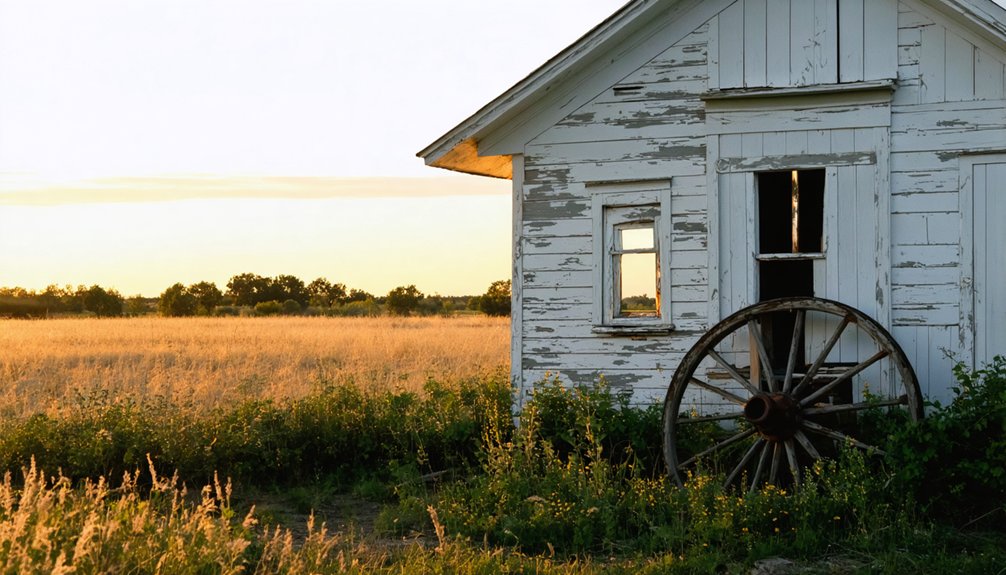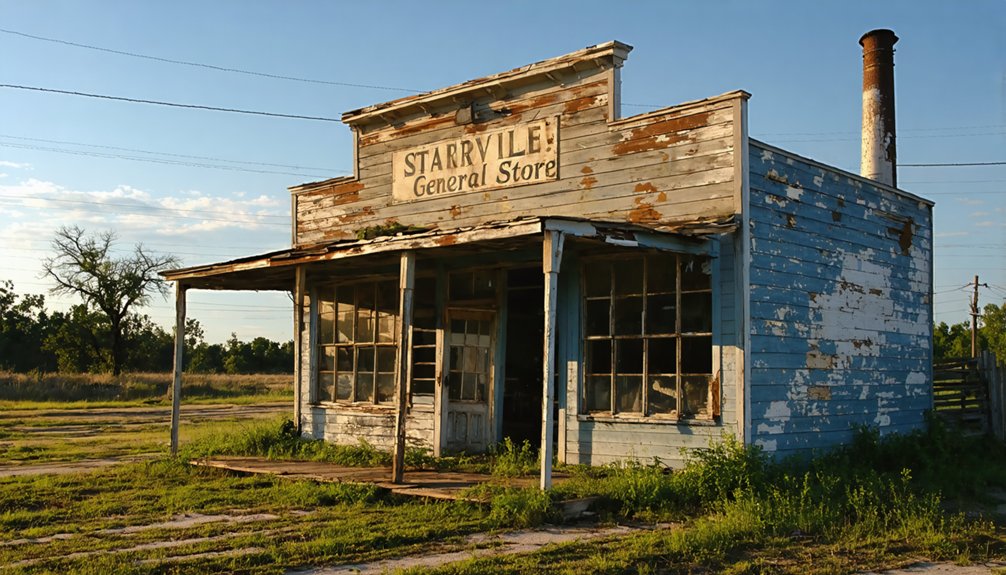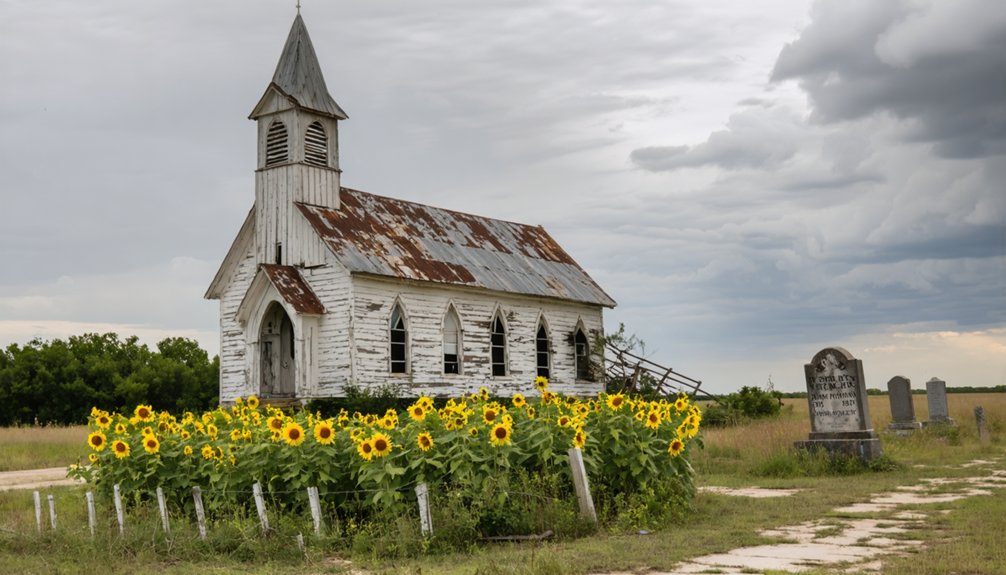You’ll find Starrville, Texas nestled along the historic Dallas-Shreveport road in Smith County, where it once flourished as the region’s second-largest city. Founded in 1852 by Reverend Joshua Starr, this Methodist settlement banned liquor sales and established renowned educational institutions. While the town’s glory days ended after the Civil War, you can still visit its remaining church, cotton gin, and cemetery. The story behind Starrville’s rise and fall reveals fascinating chapters of Texas history.
Key Takeaways
- Starrville was Smith County’s second-largest city before declining from 200 residents in 1892 to 122 by 1907, leading to ghost town status.
- Only a church, city well, cotton gin, and cemetery remain as physical evidence of Starrville’s once-thriving community.
- The town’s demise accelerated after losing its post office in 1907 and the Masonic Lodge’s relocation to Winona.
- Founded by Reverend Joshua Starr in 1852, the town flourished with Methodist values, prohibition on liquor, and focus on education.
- School consolidation between Winona and Gladewater contributed to community fragmentation and the loss of essential businesses.
The Birth of Gum Springs Settlement
While natural hot springs and abundant gum trees first attracted settlers to the area in 1850, the settlement that would become Starrville began as Gum Springs – a name derived from its most prominent natural features.
Natural springs and towering gum trees drew pioneers to this untamed land, giving birth to the settlement of Gum Springs.
You’ll find that before white settlers arrived, Tonkawa and Cherokee refugees used these springs as a gathering place.
In its early days, Gum Springs served as a crucial shipping point for local farmers, establishing itself as a hub of regional commerce. The community’s location at natural crossroads made it an ideal stop for stagecoach travelers between Dallas and Shreveport.
The community’s significance grew when it established its first post office in 1850, with Rice Wells serving as postmaster.
The post office, centered around a popular swimming and baptismal hole, marked Gum Springs as a recognized settlement before its transformation into Starrville in 1852 when Reverend Joshua Starr purchased 640 acres in the area.
A Strategic Stop on the Dallas-Shreveport Line
The strategic location of Starrville along the Dallas-Shreveport road shaped its early development and regional importance. By 1849, you’d find this Smith County settlement serving as an essential stop on one of Texas’ major transportation routes connecting two emerging urban centers.
Reverend Joshua Starr purchased the land in 1852 and began selling town lots to eager settlers. The town’s position leveraged existing trails that predated railroad construction, making it a natural hub for goods, people, and information moving through antebellum Texas. The Texas and Pacific Railway would eventually establish a major line through the region, completing the Marshall to Texarkana segment on December 28, 1873.
You’ll appreciate how Starrville’s placement made it a promising candidate for future rail development as the region’s infrastructure evolved. While economic shifts would later favor rail-connected towns, particularly after the Texas and Pacific Railway’s arrival in 1873, Starrville’s role in the Dallas-Shreveport corridor represents a significant chapter in early Texas transportation history.
Reverend Joshua Starr’s Vision and Legacy

You’ll find Reverend Joshua Starr‘s Methodist roots deeply embedded in Starrville’s origins, as this Alabama minister purchased 640 acres in 1852 to establish a moral, religious community.
His town planning reflected strict Methodist principles, including a prohibition on liquor sales and the establishment of the Starrville Methodist Church as the town’s spiritual anchor in 1853.
This commitment to Methodist values aligned with his family’s long tradition, as the Starrs had been connected to early American Methodism since the movement’s first conference in Georgia in 1788.
The Masonic Lodge began meeting above the Methodist church, creating an additional layer of community organization and fellowship.
Through his religious leadership and civic development efforts, including founding educational institutions and supporting community infrastructure, Starr created a lasting Methodist pioneer legacy that defined early Texas frontier development.
Methodist Roots Run Deep
Reverend Joshua Starr’s founding vision for Starrville in 1852 established deep Methodist roots that would shape the town’s character for generations. As a minister from Alabama, he purchased 640 acres to create a faith-centered community where Methodist influence would guide daily life.
You’ll find his principles reflected in the town’s strict prohibition of liquor sales and the establishment of the Starrville Methodist Church in 1853.
The Methodist values permeated every aspect of the community’s development, from education to civic planning. You can trace Starr’s impact through the founding of gender-segregated schools, later unified as Starrville Union Academy, and the careful layout of town lots emphasizing order and morality.
His role as both religious leader and community figurehead cemented Methodism’s lasting imprint on Starrville’s identity.
Town Planning and Faith
While establishing Starrville in 1852, Joshua Starr masterfully integrated his Methodist principles into every aspect of town planning through strategic land management and deed restrictions. His faith integration shaped the 640-acre settlement with permanent alcohol prohibitions written into property deeds, ensuring his vision of a moral community would endure.
Under Starr’s community governance, the town quickly developed essential infrastructure centered around the Starrville Methodist Church, built in 1853. Starr used the sale of household enslaved people to fund his various real estate ventures.
You’ll find his influence reflected in the establishment of gender-separated schools that later merged into Starrville Union Academy. The town flourished with gristmills, sawmills, foundries, and various businesses, all operating within his Methodist-inspired framework.
His strategic planning created a self-sufficient community where commerce, education, and faith worked in harmony.
Creating Methodist Pioneer Legacy
A pioneering spirit marked Joshua Starr’s influential role in establishing Methodism across East Texas during the 19th century. Alongside his brother Henry, he strategically coordinated Methodist outreach efforts that shaped both religious and social life on the frontier.
His marriage to Fenton Melear and their thirteen children helped establish deep roots for the Methodist movement. Following the example of Bryan Marsh and other early settlers who arrived in 1854, many families were drawn to the growing community. You’ll find his legacy deeply woven into the fabric of East Texas, where he designed innovative programs that balanced worship with community cohesion.
As one of the “fathers of Methodism in Texas,” Starr’s vision extended beyond traditional church services. He created gathering spaces that served multiple purposes, fostering strong bonds among settlers while addressing their spiritual needs.
His approach proved particularly effective in areas where indigenous peoples and Anglo settlers intersected, establishing resilient Methodist communities that would influence Texas religious life for generations to come.
Life in Early Starrville Community

During its early years, Starrville flourished as Smith County’s second-largest city, fostering a vibrant community built on temperance and education. The town’s community values reflected Reverend Starr’s vision of an orderly society, where liquor sales were prohibited and educational institutions took center stage. The town’s location along the Dallas-Shreveport road made it an important trading hub for the region.
Founded on principles of education and sobriety, Starrville exemplified Reverend Starr’s dream of a moral, knowledge-focused society.
If you’d visited Starrville in the 1850s, you’d have found:
- Separate male and female high schools that later merged into the prestigious Starrville Union Academy
- A bustling commercial district with gristmills, foundries, and wagon maker shops
- Healthcare providers including doctors and dentists serving local residents
- A post office connecting the town to regional communication networks
The town’s self-sufficient economy supported various craftsmen and merchants, while its educational focus attracted families seeking quality schooling for their children.
Civil War Years and Military Significance
The Civil War transformed Starrville’s peaceful community into a bustling military hub when Confederate forces established one of Smith County’s largest encampments there in 1862. Under Gen. Henry E. McCulloch’s command, troops prepared for their Little Rock expedition, utilizing nearby Camp Clough and Camp Ford for training and prisoner detention.
You’ll find Starrville’s wartime significance enhanced by its strong Confederate allegiance, with residents supporting Democratic politics and Texas secession. The community organized local patrols and established post hospitals staffed by women volunteers.
While the town’s rejection of railroad construction complicated military logistics, Starrville maintained its cultural importance through institutions like the Union Academy and Methodist Church. These establishments served as anchors for community life throughout the conflict, even as the region contributed significant infantry and cavalry units to the Confederate cause.
The Decline of a Once-Thriving Town

While Starrville once flourished as a vibrant community of 200 residents in 1892, its dramatic decline became evident when the population plummeted to just 122 by 1907.
The economic changes that swept through this Texas town left an indelible mark, triggering widespread population migration to neighboring communities.
You’ll find the town’s descent marked by four crucial losses:
- The post office’s closure in 1907, ending Starrville’s official status
- Relocation of the Masonic Lodge to Winona, fragmenting civic life
- School consolidation that split the community between Winona and Gladewater
- Disappearance of essential businesses, including the hotel and gristmill
Today, you’ll see only glimpses of Starrville’s former glory: a church, city well, cotton gin, and cemetery – silent witnesses to a once-thriving community.
What Remains: Historical Markers and Ruins
Despite extensive historical records documenting Starrville’s vibrant past, you’ll find remarkably few physical remnants of this once-thriving Texas town today.
Time has erased nearly all physical traces of Starrville, though history books still tell tales of this lost Texas town.
What was once a bustling community with stores, mills, and professional services has seemingly vanished into the Texas landscape, leaving behind no documented ruins or standing structures.
You won’t find any official Texas Historical Commission markers or preserved buildings to commemorate this ghost town‘s historical significance.
The town’s legacy lives on primarily through written historical sketches and genealogical records rather than physical landmarks.
If you’re hoping to explore Starrville’s remains, you’ll face challenges – there are no documented archaeological surveys, and even the exact location details aren’t readily available in public sources.
Frequently Asked Questions
What Natural Disasters or Epidemics Affected Starrville’s Population Over the Years?
Surprisingly sparse sources show no significant hurricane damage or disease outbreaks affected your town’s decline. You’ll find economic factors, particularly the railroad’s bypass, played a bigger role than natural disasters.
Were There Any Native American Settlements in the Starrville Area Before 1852?
You’ll find evidence of Native settlements in the area, primarily Caddo Indians and Anadarko tribes, who left indigenous artifacts dating back centuries before Starrville’s 1852 founding.
What Businesses and Stores Operated in Starrville During Its Peak Years?
In its heyday, you’d find local businesses hitting their stride with three mercantile stores, a millinery shop, cotton gins, gristmills, sawmills, foundries, and a hotel serving travelers along Dallas-Shreveport Road.
Did Any Notable Outlaws or Criminal Incidents Occur in Starrville?
You won’t find records of major outlaws or criminal activities specific to Starrville. While East Texas saw its share of frontier lawlessness, there’s no documented evidence of notable incidents in this town.
How Many Families Lived in Starrville at Its Maximum Population?
You’ll find that with a peak population of 200 residents in 1892, Starrville likely housed between 40-50 families, though exact family demographics and population growth patterns aren’t precisely documented.
References
- https://www.ghosttowns.com/states/tx/starrville.html
- https://www.texasescapes.com/EastTexasTowns/Starrville-Texas.htm
- https://en.wikipedia.org/wiki/List_of_ghost_towns_in_Texas
- https://www.dreamstime.com/joshua-starr-methodist-minister-alabama-bought-acres-land-plotted-starrville-one-oldest-towns-smith-image207395063
- https://www.hmdb.org/m.asp?m=92267
- https://discovertexasoutdoors.com/places/starrville-texas-an-early-dry-town-with-a-lost-railroad-connection/
- https://www.bartondatabase.com/getperson.php?personID=I18092&tree=gbtree&sitever=mobile
- https://www.texasescapes.com/TOWNS/Texas-Ghost-Towns-8-South-Texas.htm
- https://www.sfasu.edu/heritagecenter/4760.asp
- https://www.hmdb.org/m.asp?m=33407



